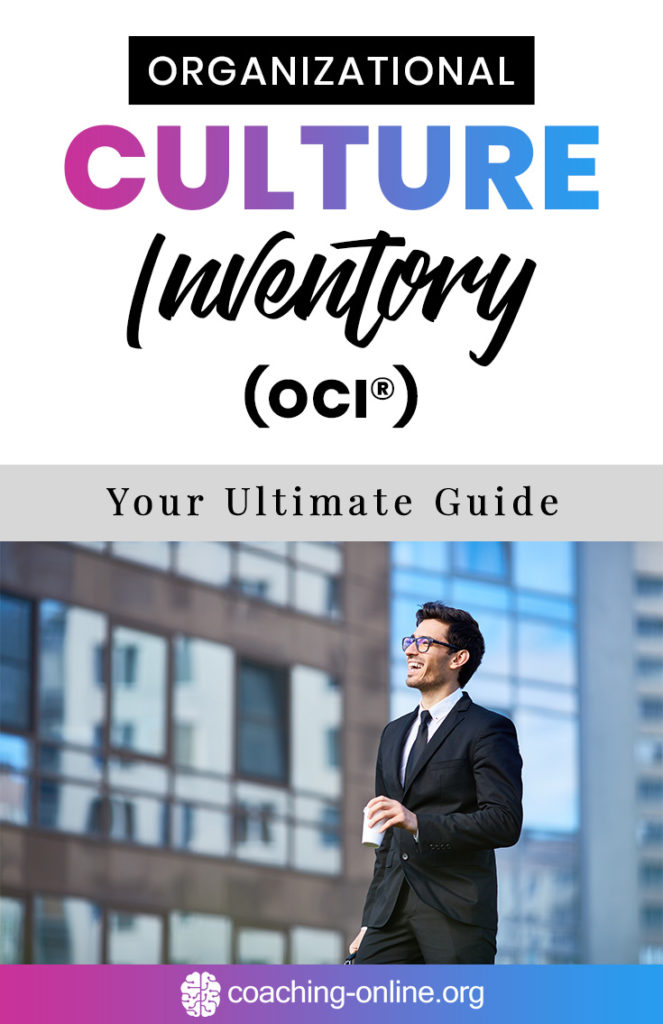You’re about to learn all you need to know about how Organizational Culture Inventory (OCI) can help you as a business leader.
As a business coach who has worked with leaders in various fields, I have no qualms about recommending OCI to you.
Below, we’ll explore what OCI is, how to use it and the benefits of doing so.

What is Organizational Culture Inventory?
The Organizational Culture Inventory (OCI) is a patented assessment for measuring organizational culture.
It was developed following more than 20 years of research by a team led by Dr. Robert A. Cooke and J. Clayton Lafferty.
This assessment can only be delivered by consultants who are accredited by a company called Human Synergistics.
It can be used effectively by organizations in any field, and has therefore grown to become the most widely used assessment of its kind.
Importantly, the assessment meets various academic and psychometric standards.
It has been used to facilitate research within a number of prestigious academic journals.
While there are other ways of measuring company culture, this solution from Human Synergistics is widely recognised as the most reliable.
What are the two types of Organizational Culture Inventory?
There are two types of OCI assessment available. These are:
- The standard OCI assessment measures the current culture of your organization.
- The OCI-Ideal assessment is essentially an add-on, which also reveals the ideal culture for your company.

What is organizational culture and why does it matter?
Organizational culture is also widely known as ‘company culture’.
This HR buzz phrase is used to describe the expectations and behavioural norms of those working within an organisation.
This covers how employees are expected to interact with each other and with customers, as well as the manner in which they are expected to perform tasks.
These shared values are typically decided by those highest in the corporate chain and passed downwards.
If someone high up in the corporate chain ignores certain aspects of company culture, it is common that those below them will think it’s acceptable to do the same.
This is known as a ‘weak’ company culture.
When a company has a ‘strong’ culture, staff are extremely aware of what it means to work for this organization.
The expectations are made very clear – and new staff will quickly be taught these so they can fit in and meet the strict standards of the company too.
However, a ‘strong’ company culture might not necessarily be a good one.
These are two different things entirely.
It is possible for an entire workforce to be painfully aware of a culture that stinks…
An ideal culture would encourage employees to work to their full potential, while also creating an enjoyable atmosphere for them.
After all, an enjoyable company culture will boost employee engagement and staff retention, which will naturally boost the performance of the business as a whole.
Indeed, the perfect balance between ‘work hard’ and ‘play hard’ would appear to be the goal that most companies are aiming for.
A highly-cited study study by Professors J. P Kotter and J. L. Heskett suggested that a great company culture can result in a 20-30% increase in employee performance, compared to “culturally unremarkable” competitors.
This is why you see businesses invest so much money into improving their company culture.

How does Organizational Culture Inventory (OCI) work?
The OCI is a survey consisting of 120 simple questions. It supposedly takes around 20 minutes to complete.
The process of administering this survey and evaluating the results is completed by an accredited Human Synergistics consultant.
You can either hire an external consultant or pay for your HR staff to become OCI-accredited (if they’re not already).
You may want to issue this survey on a regular basis to account for a natural change in your organizational culture over time.
The assessment can be issued to as many employees as you see fit, although you’ll get a clearer idea of your current culture if the majority of your staff complete it.
You may choose to pay attention to the variance in answers between departments, in order to get an idea of ‘sub-cultures’ within your business.
The assessment can be self-scored or marked by your OCI-accredited consultant depending on your preferences.
The questions are designed in a way that makes it clear what the current expectations are, as far as behavioural norms within your organization.
The OCI-Ideal assessment will also paint an accurate picture of your employees’ ideal culture.
Afterwards, your OCI-accredited consultant will guide you on how to interpret the results of the assessment and the culture change you should implement as a result.
They will also be able to support you with ideas on how to implement this change.
What are the benefits of implementing Organizational Culture Inventory (OCI)?
When you invest in Organizational Culture Inventory (OCI), you can expect to:
- acquire accurate and reliable data on your current culture;
- gain valuable insights on employee satisfaction;
- discover where and how your company culture needs to change;
- implement the changes that are most likely to improve performance;
- be able to back up your ideas when explaining the need for cultural change to others;
- evaluate the impact of previous efforts to implement cultural change;
- avoid the constructive passive responses which tend to be delivered with other types of employee surveys.
This type of assessment is often desired when new leaders join an organization, especially at the very top of the business or within the human resources department.
Indeed, an OCI will often take place just after a merger or acquisition.
It can often take several months of consistent work to successfully encourage a notable change in culture, in terms of day-to-day behaviour.
Nevertheless, this can have a remarkable impact on the performance and general job satisfaction among employees at all levels.
It’s often recommended to organise a second OCI assessment to measure the effectiveness of previous efforts to encourage cultural change.
How much does Organizational Culture Inventory cost?
To discover the cost of hiring an OCI-accredited consultant or getting an accreditation for your staff members, you’ll need to contact Human Synergistics for a quote.

Are there any alternatives to Organizational Culture Inventory (OCI)?
The Organizational Culture Assessment Instrument (ACAI) is an alternative worth mentioning.
It was developed by Kim Cameron and Robert Quinn at the University of Michigan and has reportedly been utilized by over 10,000 companies.
In this assessment, respondents are asked to rate what Cameron and Quinn determined are the “six company culture aspects that matter” for their organization.
These are:
- dominant characteristics;
- organizational leadership;
- management of employees;
- organizational glue;
- strategic emphases;
- criteria of success.
In another section of the assessment, they are asked to rate:
- Internal vs external orientation. The extent of which the organization focuses on the development of their own facilities and staff vs developments in the outside market.
- Stability vs flexibility. The extent that is accepted for staff members to ‘bend the rules’, in order to get the job done.
After rating their organization for each of these aspects, respondents are asked to rate what their ideal culture would look like.
The rating system involves dividing 100 points across four statements, with more points being assigned to those they believe to be the most true.
This scoring system has supposedly been deliberately designed to bring business leaders the most useful insight into their company culture.
How has Organizational Culture Inventory (OCI) affected your company?
Have you used Organizational Culture Inventory (OCI) or Organizational Culture Assessment Instrument (ACAI) in your business?
Was it successful in boosting cultural change and the overall performance of your employees? Or do you think it’s just a pointless human resources exercise?
I’d love to hear about your experiences, so drop a comment below.
Related Posts
Achievement Oriented Leadership – A Complete Guide
12 Main Reasons Why Entrepreneurs Experience Daily Stress, And How to Prevent Them
